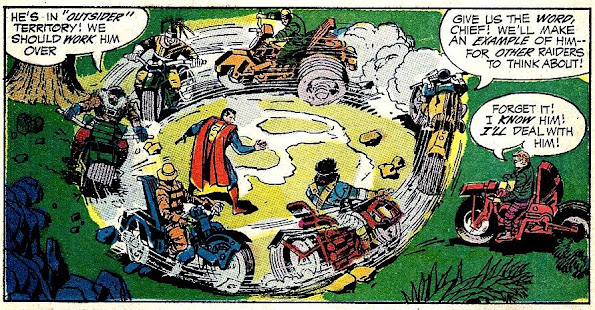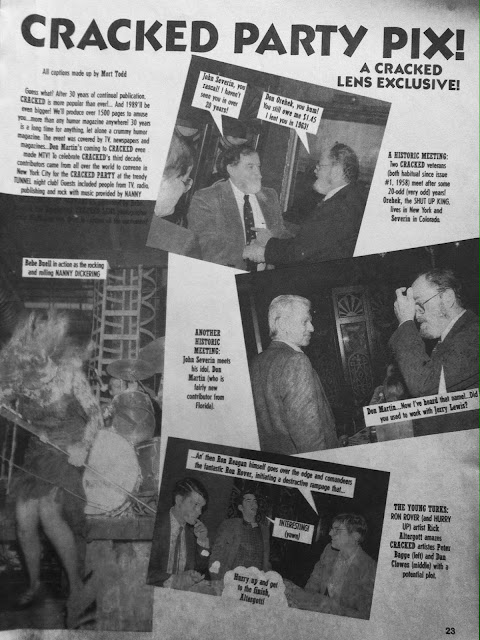Friday, October 04, 2019
I’m Sorry, the Card Says “Moops"
by BK Munn
In the Season 4, episode 7 episode of Seinfeld, “The Bubble Boy”, George plays a game of Trivia Pursuit with the obnoxious Bubble Boy and finally gets the upperhand by spitefully refusing to accept that a misprint on one of the cards should read “MOORS” instead of the nonsensical “MOOPS”.
Vexed by bubble-bound Donald Sanger's bullying during the game, George disputes the answer to the question: "Who invaded Spain in the 8th century?" Donald answers "the Moors," but due to a misprint, the question card says that the answer is "the Moops." George refuses to give Donald the point, and Donald begins strangling him. When Susan tries to help George, she accidentally depressurizes the bubble, causing Donald to collapse.
The plot of this episode is based in part on the real-life experience of Seinfeld writer Bill Masters who found the “MOOPS” answer while playing a version of the Jeopardy boardgame (the 9th edition). Here’s the card, and the game:
Now you know!
Friday, August 23, 2019
Early Darwyn Cooke Comics from Music Express
by BK Munn
Cartoonist Darwyn Cooke (1962-2016) got his start in the Toronto magazine world back in 1984 when he was hired as the art director for Music Express. He did all the design, graphics and even some photography for that magazine, and its sister mag Metallion, until he left to work for one of Canada’s biggest fashion magazines, Flare, in 1988. Looking at these issues of Music Express, you can see how Cooke was applying a retro mid-century design sense to its pages in a style that nevertheless still retains a very hip 1980s feel. The pages from this 1985 issue are crammed with Cooke’s spot illustrations and there is even a house ad done in the form of a comic strip. This is some of Cooke’s earliest published comics.
Cartoonist Darwyn Cooke (1962-2016) got his start in the Toronto magazine world back in 1984 when he was hired as the art director for Music Express. He did all the design, graphics and even some photography for that magazine, and its sister mag Metallion, until he left to work for one of Canada’s biggest fashion magazines, Flare, in 1988. Looking at these issues of Music Express, you can see how Cooke was applying a retro mid-century design sense to its pages in a style that nevertheless still retains a very hip 1980s feel. The pages from this 1985 issue are crammed with Cooke’s spot illustrations and there is even a house ad done in the form of a comic strip. This is some of Cooke’s earliest published comics.
Friday, August 09, 2019
Jack Kirby, Manson, and The Hippies
by BK Munn
"I feel my characters are valid, my characters are people, my characters have hope. Hope is the thing that'll take us through."
I often forget to think of the political and social context of the late-1960s and early-1970s when reading Jack Kirby’s Fourth World comics. Sure there are obvious nods to and caricatures of both comics people and politicians of the day in his work, but the comics are also full of the dread and optimism of the day. Kirby was creating during the Vietnam War and the political conflagration of the anti-War movement, the Civil Rights movement, Second-wave feminism, assassinations, the Boomer youth culture, the Cold War and the Space Race. Today is the 50th anniversary of the Tate-LaBianca murders and it struck me recently while looking into where Kirby actually lived that he arrived in California right in the middle of all the Manson craziness.
The story of Kirby’s first house in California has often been told: How the Kirbys built their dream house only to be forced to move by the noise created by the kids on motorcycles driving around in the valley underneath Jack’s studio, and how those same bikers later found there way into Jimmy Olsen as “The Outsiders”. The Kirby family moved from their dream house into another property in Thousand Oaks and that is the house that most people talk about visiting for the next 20 years or so, until Jack’s death in 1994. (Thanks to Mark Evanier we also now know that Kirby’s first house (the “dream house”) on Lynn Road was just down the road from MGM’s Jungleland theme park, and that the Kirby’s drove by it all the time (possibly an inspiration for “The Zoomway” and the “Wild Area” in Jimmy Olsen).)
In reference to Jack’s “open door” policy towards fans who dropped in on his final Sapra Street home studio unannounced, Linda Kirby is often quoted as saying “if Charles Manson came calling, Jack would let him in.” This got me thinking of the milieu Kirby found himself shortly after moving to the Los Angeles area in the late-60s. Shortly after arriving, the Manson murders gripped the city and the nation. Contemporary accounts of the arrest of Manson and his followers in 1969 describe “a band of nude and long-haired thieves who ranged over Death Valley in stolen dune buggies” --more Hairies and Outsiders inspiration, I’m sure. However, one of the great strengths of Kirby’s work during this period is the optimism he invests in the young “hippie” characters he creates (think Forever People et al) at the same time as some of his work explore the darker underbelly of the Summer of Love and the end of the Sixties. Manson finds his way into many of the sadistic and charismatic characters of the New Gods saga, Darkseid and his cultish minions like Glorious Godfrey, Desaad, Wonderful Willik, and many others, but these are always countered by the good natured heroes of New Genesis, many characters based on younger people Kirby met and worked with, including his own children.
Wednesday, July 10, 2019
Cracked in Canada
by BK Munn
Way back in 1994, Cracked Magazine went Canuck-crazy with a special variant edition lampooning Canadian culture, a shameless pandering that only the geniuses behind a bargain-basement version of MAD Magazine could have conceived of (although there was a French-Canadian version of MAD produced by the gang behind Croc around the same period that ran for a few years). Beginning with the cover, instead of the Beavis and Butthead parody U.S. audiences were treated to, the Canadian version boasts a John Severin-drawn hockey punch-up featuring what appears to be legendary Toronto Maple Leafs brawler Doug Gilmour. The rest of the issue is dotted with a smattering of Canadian-themed features, including a generic Don Martin gag with a Newfoundland setting randomly inserted in the title.
Thursday, June 13, 2019
The First Talking Cartoon Cat?
by BK Munn
Woodcut by unknown artist from frontispiece to The Excellent and Renowned HISTORY of the Famous Sir Richard Whittington, Three Times Lord-Mayor of the Honourable City of London (1690). This is a relatively “late” retelling of the story of Dick Whittington and his Cat, from a widely-circulated London chapbook. I love that this woodcut has the cat speaking in an early form of comic strip word balloon. These types of emanata are usually called “phylacteries" by art and comics historians, after the scroll-like ribbons of text and speech that first appeared in medieval manuscript illuminations. I wonder how many other early “talking cat” images are out there? There were many similar chapbooks devoted to Aesop’s Fables, plays, ballads, various fairy tales, nursery rhymes, morality tales, etc. Is there a Puss in Boots, witch’s familiar, or some other talking cat with a similar phylactery in a book or painting that pre-dates this one?
Thursday, June 06, 2019
Monday, April 22, 2019
Rudolph Dirks Anticipates the Group of Seven
by BK Munn
Rudolph Dirks took the characters of his Katzenjammer Kids strip around the world many times before they more or less settled down on a tropical island, and one of their earliest adventures was a search for the North Pole. As part of this epic 1907 quest, the trio of The Captain, Hans and Fritz travelled through the arctic, battling polar bears and meeting other northern inhabitants, including racist caricatures of Inuit people who speak in gibberish. The Captain, like Dirks himself, just wants to travel and paint pictures, but is constantly pranked by the kids. In the sequence below, he likens the painting of a pine tree to poetry, echoing Robert Service’s "The Pines” and presaging both Joyce Kilmer’s famous poem “Trees” (“I think that I shall never see/a poem lovely as a tree...”) and the paintings of Tom Thompson and the Group of Seven, notably Thompson’s “The Jack Pine”. Dirks was a fellow traveller of The Ashcan School of painters and was one of the cartoonists who exhibited in the Armoury Show of 1913.
Saturday, March 16, 2019
Cracked Magazine Party Pix: December 1988 (Clowes,Bagge, Altergott, Severin, Martin)
Subscribe to:
Posts (Atom)























































